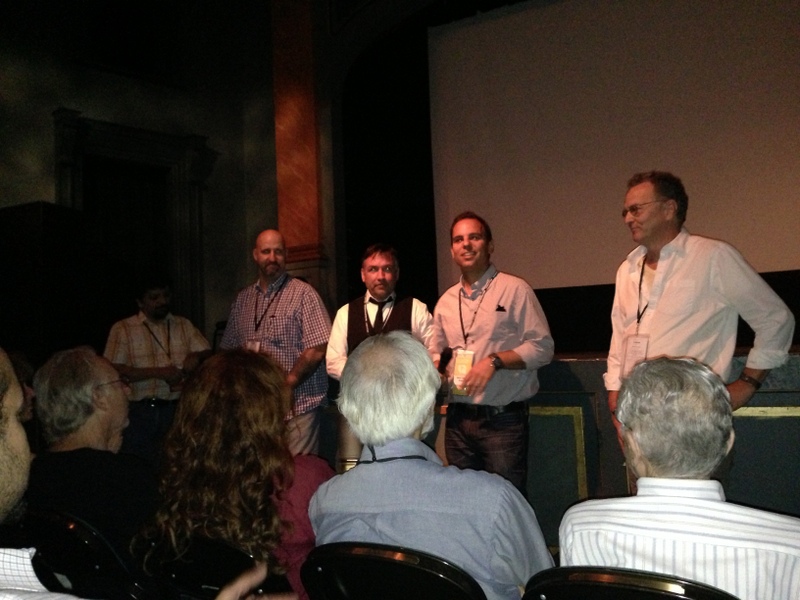
Several former prison/actors on stage at Mill Valley film festival (Photo by Rose Paccate)
“’John Brown’s Body’ at San Quentin Prison,” a movie about the making of a play inside San Quentin and starring San Quentin prisoners, premiered last October at the Mill Valley Film Festival in northern California just a few miles from the prison itself. I felt honored to be in the audience with five of the former prisoners turned actors and their families present. All of the former prisoners had, at one time, been sentenced to life in prison, but have now been released. In fact, only three prisoners in the original 2002 play and movie cast are still incarcerated; one, released, could not be contacted.
The prison play was based on the poem, “John Brown’s Body.” Brown was a radical abolitionist, who with his sons and others, carried out a raid on the federal armory at Harper’s Ferry, Va, in 1859. Brown believed that an armed insurgence was the only way to overturn slavery. Ironically, the first man killed was a free black man. The raid was unsuccessful as Brown and his group killed four men and injured several. Ten of Brown's men, including two of his sons, were also killed. Brown was eventually hanged, as was another of his sons. Brown’s actions at Harper’s Ferry and other sites, aimed to rid the country of racial slavery, are believed to have been pivotal to events leading to the Civil War.
The poem, like the prison play, and the documentary, rest on poignant racial themes.
For context, it is useful to recall that the United States has the largest prison system in the world. Though the U.S. population is only approximately four percent of the world population, America currently has approximately 25 percent of all the prisoners in the world. There is also a correlation among race, poverty and prison populations in the U.S. Race conflates past and present U.S history, and is the dominant theme that transcends the personal, social, cultural and political dimensions of life at San Quentin and of the play, “John Brown’s Body."
The recently released documentary about the production of the unlikely San Quentin play begins with some background about how the play and film came into being. It’s done through interviews with nine actor-prisoners. Around and around it goes, moving forward and upward, the narratives weaving sequences of the poem’s dramatic performance with the actor prisoners’ comments. The documentary records their responses to being asked to act in a play in the first place and how their ideas toward the play changed in the three years it took to be produced. Originally skeptics almost to the last, the cast members slowly broke through their racial enclaves, eventually forming a one of a kind cohesive interracial group. It took enormous efforts. The film examines personal suspicions, stereotypes, and stories that explore what moved them to crime in the first place. Actors, both white and black, played the parts of Union soldiers, northerners, southerners and slaves.
The documentary scenes of the prisoners’ performances, putting on the play with pride, after years of work, are riveting. One prisoner/actor named Ronin, playing Abraham Lincoln, had a terrible time memorizing his lines and was so nervous he fainted before the first performance. But Ronin’s soliloquy is award-worthy. It is at this point when the emotions that have been building during the film reach a crescendo. You know you are seeing something extraordinary, something transcending, something speaking to nothing less than human redemption.
These San Quentin prisoners turned actors, stepping back into history and into an earlier captivity, become the protagonists of the poem. They stand before their audiences, men whose deeds have been condemned, then – and now, again, and are seen warehoused in a dehumanizing prison system where racism is still part of every aspect of life.
Women are not allowed in the prison and so director Joseph De Francesco decided that the women would appear on a video projected against a large stage screen. He chose a local stage actress named Blancett Reynolds to play all the female roles, and like the actors, she wore the same simple clothing throughout. The dialogue and direction of her filmed gaze integrated perfectly with the men speaking in real time on the stage. This minimalist stylized audiovisual technique together with the stark live performance gave me goose bumps.
The poignant musical score for the performance was composed and conducted by Arthur B. Rubenstein and performed live by the Pacific Mozart Ensemble, a first for San Quentin as well. The music is not available at this time but De Francesco said that “The final piece, ‘A Balm in Gilead’ is available on an album by the male choral group Chanticleer.” The music used in the documentary, however, comes from three different composers.
That the play ever came to be is a miracle in itself. The men showed up for drama workshops and rehearsals inconsistently, either because they could only come during the little free time they had, they didn’t feel like it or because they sometimes were in solitary confinement, "the hole," for some prison infraction, or in one case, for their own safety.
One white actor prisoner was beaten for hanging out with blacks.
The actors wore no costumes. Walking sticks were used as props for rifles. They never had a single rehearsal with everyone all together in the small room available to them, with a sign over the door reading: “Arts in Corrections.”
“These guys stayed with it, this was the key," De Francesco said. “ I want to give them credit because it was all so crazy, so improbable; they had never seen anything like this. They are very bright guys, but they didn’t have a lot of formal education except what several of them got while in prison. They stuck with it never thinking it would be actually be performed or made into a movie. They were always being disappointed in prison and I did not want to add to that. When a prisoner would get transferred without warning, and a new prisoner had to step in, the others would have to teach him to memorize his lines in their cells, line by line.”
As “John Brown’s Body at San Quentin Prison” begins to make the festival rounds, De Francesco said that he would not have been able to make the film, cobbled together using pre-HD footage from Beta SP, to mini video, to video from whatever equipment he could get his hands on, without Suzanne Colwell, formerly of Wells Fargo and now retired, where De Francesco worked as a video editor. Colwell allowed Joe to use the editing suite and this made the documentary possible – once the prison gave permission, of course, for additional footage to update the story. The quality of the film in some parts reflects that many of the images had to be enlarged by 30 percent to be integrated into the film. But for me, after the first 10 minutes or so, one no longer notices.
At the October premier, five former prisoners answered questions about the making of the play and the documentary. They spoke of their lives, then and now, as they had in the documentary itself. One audience member asked how the men are “paying their debt to society” now that they have served their time. The former prisoners answered:
“When we began this process it may have proven to be a catalyst to us all as we began to expand our thinking in looking at life from a different perspective. ... All the programs that were formed [in San Quentin] as a result of what we did is the legacy that we left on the inside and for me, where redemption meets my reality is here today - when you say to us that you appreciate the contribution that we made and will continue to make because of the work that Joe [De Francesco] has done and how it will be viewed and used as maybe as an educational tool for all we know. We are hopeful that it will get a chance to speak about what the changes in our lives has actually produced and leave as a result going forward, I think that’s what redemption really is, how you impact the lives of those you come in contact with going forward.”
The film shows what is possible by showing humanity, respect for persons, education, and the arts, when prisons have real rehabilitation programs. After seeing the film, one can only ask: aren’t these the kind of men we want to have among us when they are released from prison?
[Sr. Rose Pacatte, a member of the Daughters of St. Paul, is the Director of the Pauline Center for Media Studies in Los Angeles.]




